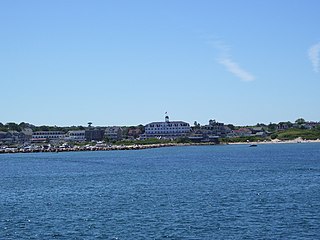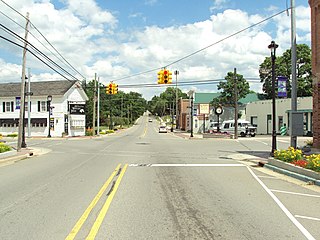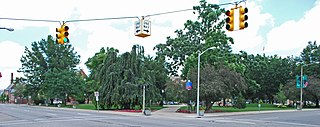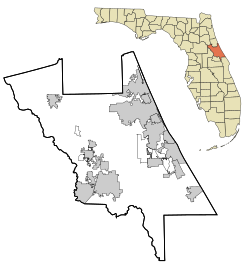
Orange City is a city in Volusia County, Florida, United States. As of the 2010 United States Census, the city had a population of 10,599. It is a part of the Deltona–Daytona Beach–Ormond Beach metropolitan area, which was home to 590,289 people in 2010.

The New Haven Green is a 16-acre (65,000 m2) privately owned park and recreation area located in the downtown district of the city of New Haven, Connecticut. It comprises the central square of the nine-square settlement plan of the original Puritan colonists in New Haven, and was designed and surveyed by colonist John Brockett. Today the Green is bordered by the modern paved roads of College, Chapel, Church, and Elm streets. Temple Street bisects the Green into upper (northwest) and lower (southeast) halves.

Enterprise is an unincorporated community in Volusia County, in the U.S. state of Florida, and its former county seat. Situated on the northern shore of Lake Monroe, it is flanked by the cities of DeBary and Deltona. Enterprise was once the head of navigation on the St. Johns River and at various times, the county seat for three different counties: Mosquito, which was renamed as Orange; and lastly, for Volusia, which was formed from part of Orange County.

The Tourist Church, also known as the Seabreeze United Church of Christ and the First Congregational Church, is an historic church located at 501 North Wild Olive Avenue in Daytona Beach, Florida, United States. Built in 1929, it was designed by architect Harry Griffin in the Mission Revival Style of architecture.

This is a list of the National Register of Historic Places listings in Volusia County, Florida.

The First Church of Christ, Congregational is a historic church at 75 Main Street in Farmington, Connecticut. Built in 1771, this Greek Revival church was designated a National Historic Landmark in 1975 for its role in sheltering the Amistad Africans before their return to Africa.

The Old Harbor Historic District is an historic district in the resort community of New Shoreham on Block Island off the southern coast of Rhode Island. Bounded by the Atlantic Ocean and Main Street, it includes Spring, High, and Water streets as well. There are 42 buildings listed in the district, which was listed on the National Register of Historic Places in 1974.

The First Congregational Church is an historic church located at 1 Church Street in Stoneham, Massachusetts. Built in 1840, it is a fine local example of Greek Revival architecture, and is a landmark in the town center. It was listed on the National Register of Historic Places on April 13, 1984. The church is affiliated with the United Church of Christ; the current pastor is the Rev. Meredith Allen.

Norwichtown is a historic neighborhood in the city of Norwich, Connecticut. It is generally the area immediately north of the Yantic River between I-395 and Route 169.

The Avon Congregational Church is a Congregational Church building at 6 West Main Street in Avon, Connecticut. Built in 1819 for a congregation founded in 1754, it is a high-quality example of Federal period architecture, and one of the finest works of architect David Hoadley. The building was listed on the National Register of Historic Places in 1972. The congregation is affiliated with the United Church of Christ.

O'Kelly's Chapel is a historic chapel located near Farrington, Chatham County, North Carolina. Named after Reverend James O'Kelly and was built about 1900. It is a modest one-room rural chapel with Gothic Revival features including a steeply pitched roof and lancet windows.

The Wananalua Congregational Church is a historic 19th-century building on the remote coast of Maui in Hawaii.

First Congregational Church is located in Burlington, Iowa, United States. It was listed on the National Register of Historic Places in 1976. The church is also a contributing property in the Heritage Hill Historic District.

The Metamora Crossroads Historic District is a historic district centered at the intersection of Oak and High Street in the small village of Metamora in Metamora Township in Lapeer County, Michigan. It was designated as a Michigan State Historic Site and also added to the National Register of Historic Places on July 19, 1984.

First Church Congregational is a historic church at Pleasant and Stevens Streets in Methuen, Massachusetts. The stone Gothic Revival structure was built in 1855 for Methuen's first congregation, established in 1729. Its first meeting house was on Daddy Frye's Hill, but moved to the present location in 1832. The present building features granite walls, a slate roof, and a tower with crenellated top and typical Gothic lancet windows. In 1895 the church installed a stained glass representation of Christ's Resurrection designed by John LaFarge.

The Greenville Downtown Historic District is a commercial historic district located in Greenville, Michigan along Lafayette between Montcalm and Benton, along with the adjacent blocks of Montcalm, Grove, Cass, and Washington on either side. It was listed on the National Register of Historic Places in 2008.

The Heritage Hill Historic District is a nationally recognized historic district located north of downtown Burlington, Iowa, United States. It was listed on the National Register of Historic Places in 1982. The area is primarily a residential neighborhood on the hill north of the central business district. Several churches act as a buffer and provide a transition from the residential area and the commercial areas in the valley. At the time of its nomination there were 141 structures in the district. The breakdown of their uses at that time included: 113 residences, 10 churches or religious use facilities, 7 public or government buildings, and 11 commercial structures. The district also includes North Hill Park, which has been in continuous use since the city was founded in 1836 and is one of the two oldest city parks in Burlington.

The Jefferson Street Historic District is a nationally recognized historic district located in Iowa City, Iowa, United States. It was listed on the National Register of Historic Places in 2004. At the time of its nomination it consisted of 39 resources, which included 36 contributing buildings and three non-contributing buildings. This section of the city started to develop to its present form in the late 19th and early 20th centuries. During this period the neighborhood was transformed from residential to include churches and buildings associated with the University of Iowa and its hospitals. Both professionals and business owners lived here, along with working-class people. Graduate students, especially those associated with the medical professions, resided in apartment buildings here. Four architecturally significant churches, along with their attendant buildings, are located in the district.

Bronson Park Historic District is a historic district in Kalamazoo, Michigan, consisting of Bronson Park and the surrounding government, religious, and civic buildings. It is roughly bounded by South Rose, South Park, West Lovell, and West Michigan Avenues. The district was listed on the National Register of Historic Places in 1983.






















